*NURSING > QUESTIONS & ANSWERS > Chapter 16--Pain Management (All)
Chapter 16--Pain Management
Document Content and Description Below
Chapter 16--Pain Management MULTIPLE CHOICE 1. A client tells the nurse that she rarely experiences pain, but when she does, she seeks medical attention. The nurse realizes this client understa... nds that pain is important because it: 1. is a protective system. 2. includes the automatic withdrawal reflex. 3. creates sensitivity to pain. 4. helps with healing. PTS: 1 DIF: Analyze REF: Definitions and Implications of Pain 2. A client complains that the bed sheets touching his skin are extremely painful. The nurse realizes this client is experiencing: 1. allodynia. 2. modulation. 3. kinesthesia. 4. proprioception. PTS: 1 DIF: Analyze REF: Peripheral Nervous System 3. A client is complaining of severe abdomen pain. The nurse realizes this client is experiencing which type of pain? 1. Neuralgia 2. Pathological 3. Somatic 4. Visceral PTS: 1 DIF: Analyze REF: Types of Pain 4. A client, diagnosed with acute appendicitis, is experiencing abdominal pain. The best way for the nurse to describe this client’s pain would be: 1. chronic. 2. neuropathic. 3. referred. 4. acute. PTS: 1 DIF: Apply REF: Types of Pain 5. A client is observed holding a pillow over the abdominal region with both knees flexed in a side-lying position. Vital signs assessment reveals an elevated blood pressure and heart rate. Which of the following should the nurse say to this client? 1. “Can I get you anything?” 2. “Would you like something for pain?” 3. “You look comfortable.” 4. “Your blood pressure is up.” PTS: 1 DIF: Apply REF: Assessing the Clinical Manifestations of Pain 6. A client experiencing chronic pain asks the nurse why she is not prescribed Demerol like she received when she had a total knee replacement. Which of the following should the nurse respond to this client? 1. “You don’t need something that strong.” 2. “That medication does not exist anymore.” 3. “That medication does not last very long.” 4. “It can cause you have high blood pressure.” PTS: 1 DIF: Apply REF: Opioid Analgesics 7. A client is informed that a tricyclic antidepressant medication is going to help control his chronic pain. The nurse would expect the physician to prescribe: 1. Amitriptyline. 2. Baclofen. 3. Gabapentin. 4. Diazepam. PTS: 1 DIF: Analyze REF: Adjuvant Medications 8. A client receiving around-the-clock medication for terminal cancer experiences additional pain when performing activities of daily living. The nurse realizes this client is experiencing: 1. breakthrough pain. 2. intractable pain. 3. psychosomatic pain. 4. acute pain. PTS: 1 DIF: Analyze REF: Breakthrough Pain 9. A client recovering from surgery tells the nurse that she is nauseated and is experiencing an increase in pain. Which of the following does this client’s symptoms suggest to the nurse? 1. The client is becoming dependent upon the pain medication. 2. The client’s pain threshold is lower when experiencing nausea. 3. The client is experiencing withdrawal symptoms from pain medication. 4. The client is experiencing referred pain. PTS: 1 DIF: Analyze REF: Pain Threshold and Pain Tolerance 10. A client with a history of malingering pain tells the nurse that he needs a prescription for pain medication. Which of the following should the nurse do first to assist this client? 1. Ask the physician for a pain medication prescription for the client. 2. Remind the client that he does not have pain but just wants the medication. 3. Thoroughly assess the client for pain. 4. Suggest the client seek counseling for his pain medication-seeking behavior. PTS: 1 DIF: Apply REF: Box 16-1 Pain Descriptions 11. The nurse is implementing the five C’s of pain management for a client. Which of the following is included in this intervention? 1. Caring for the client in a holistic manner 2. Creating a calm environment 3. Comparing the degree of pain reported with previous episodes 4. Continuously assessing the client’s pain PTS: 1 DIF: Apply REF: Planning and Implementation 12. A client, diagnosed with arthritis, should be instructed to avoid the use of NSAIDs because of which of the following prescribed medications? 1. Penicillin 2. Coumadin 3. Digoxin 4. Diazide PTS: 1 DIF: Apply REF: Box 16-2 Groups of NSAID Drugs MULTIPLE RESPONSE 1. Prior to hospitalization, a client had been ingesting high doses of oxycodone. The nurse suspects the client is experiencing symptoms of withdrawal when which of the following are assessed? (Select all that apply.) 1. Muscle twitching and spasms 2. Restlessness 3. Increased heart rate 4. Drop in blood pressure 5. Increase in blood pressure 6. Irritability PTS: 1 DIF: Analyze REF: Potential and Actual Side Effects of Opioid Analgesics 2. The nurse would be concerned that a client is at risk for developing chronic pain when which of the following health problems are diagnosed? (Select all that apply.) 1. Osteoarthritis 2. Osteoporosis 3. Heart disease 4. Diabetes mellitus 5. Chronic pulmonary disease 6. Anemia PTS: 1 DIF: Analyze REF: Chronic Pain 3. An 84-year-old client is experiencing severe arthritis pain. The nurse realizes that which of the following pain management approaches would be the most beneficial for this client? (Select all that apply.) 1. Avoid NSAIDs. 2. Utilize morphine or morphine-like medication. 3. Provide medication through the oral route. 4. Utilize diazepam. 5. Suggest Darvocet. 6. Provide medication through the intramuscular route. PTS: 1 DIF: Apply REF: Geriatric Considerations 4. A client with severe pain from spinal stenosis is prescribed Methadone. The nurse realizes that the advantages of this medication are what? (Select all that apply.) 1. Decrease in the need for antidepressant adjuvant medication 2. Less frequent dosing schedule 3. Long half-life 4. Inexpensive 5. Can be used for intermittent pain 6. Does not cause respiratory depression PTS: 1 DIF: Analyze REF: Intractable Pain 5. The nurse is using the PAINAID Scale to assess a client’s level of pain. Which of the following are assessed with this pain scale? (Select all that apply.) 1. Breathing rate 2. Assign a number to the degree of pain 3. Negative vocalizations 4. Assign a facial expression to the degree of pain 5. Facial expression 6. Body language PTS: 1 DIF: Apply REF: Skills 360: Pain Assessment Tools 6. A client diagnosed with severe arthritis tells the nurse that she always has some degree of pain. Which of the following could explain this client’s poor pain management? (Select all that apply.) 1. Client does not appear to be in pain. 2. Client does not report pain. 3. Client cannot afford pain medication. 4. Client is fearful of becoming addicted to pain medication. 5. Client believes pain medication means the condition is worse. 6. Client has a high pain tolerance. PTS: 1 DIF: Analyze REF: Barrier to Pain Assessment and Pain Management 7. The nurse determines that a client is experiencing chronic pain when which of the following is assessed? (Select all that apply.) 1. Suffering 2. Fatigue 3. Sleeplessness 4. Apathy 5. Sadness 6. Anger PTS: 1 DIF: Analyze REF: Interventions for the Management of Chronic Pain [Show More]
Last updated: 1 year ago
Preview 1 out of 6 pages
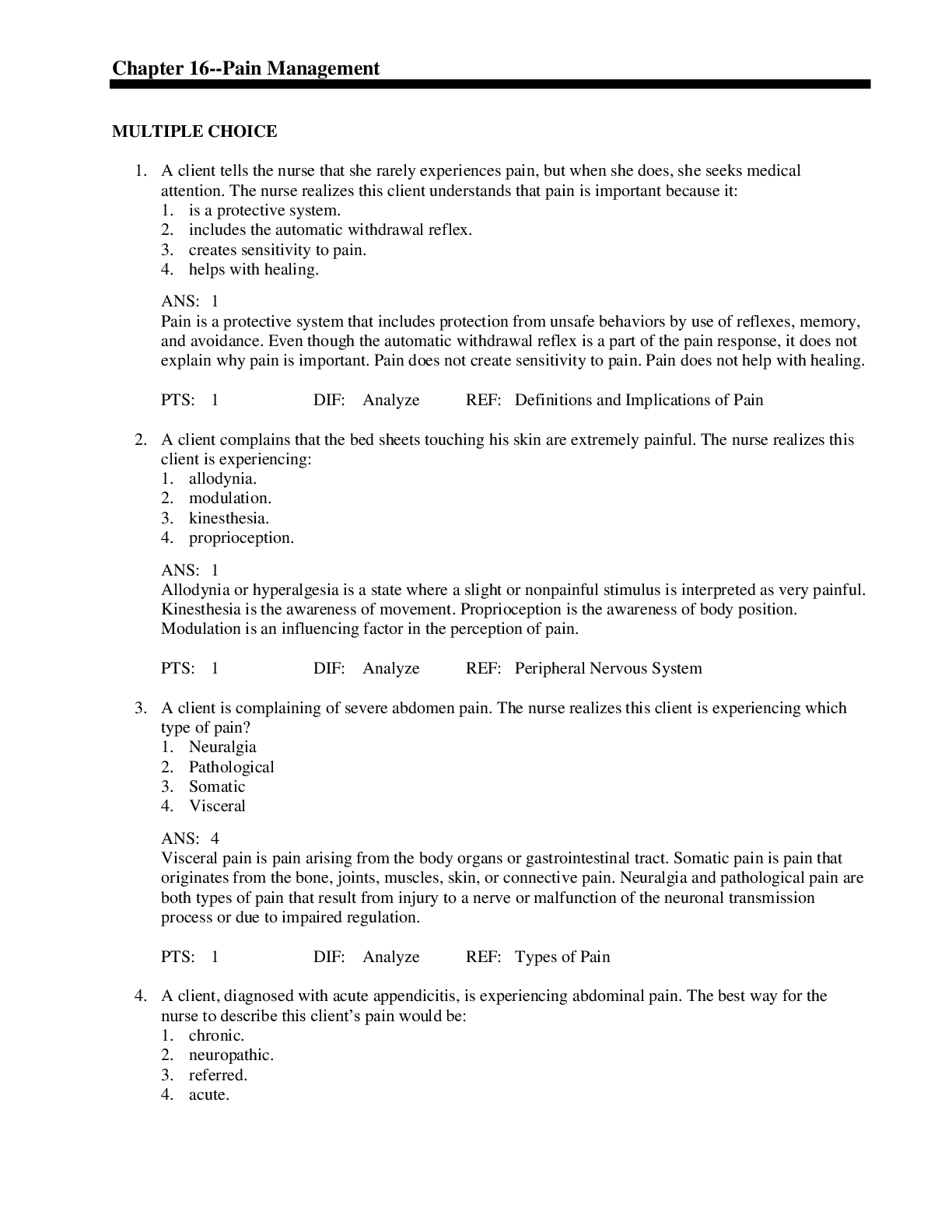
Reviews( 0 )
Document information
Connected school, study & course
About the document
Uploaded On
Jan 28, 2020
Number of pages
6
Written in
Additional information
This document has been written for:
Uploaded
Jan 28, 2020
Downloads
0
Views
36








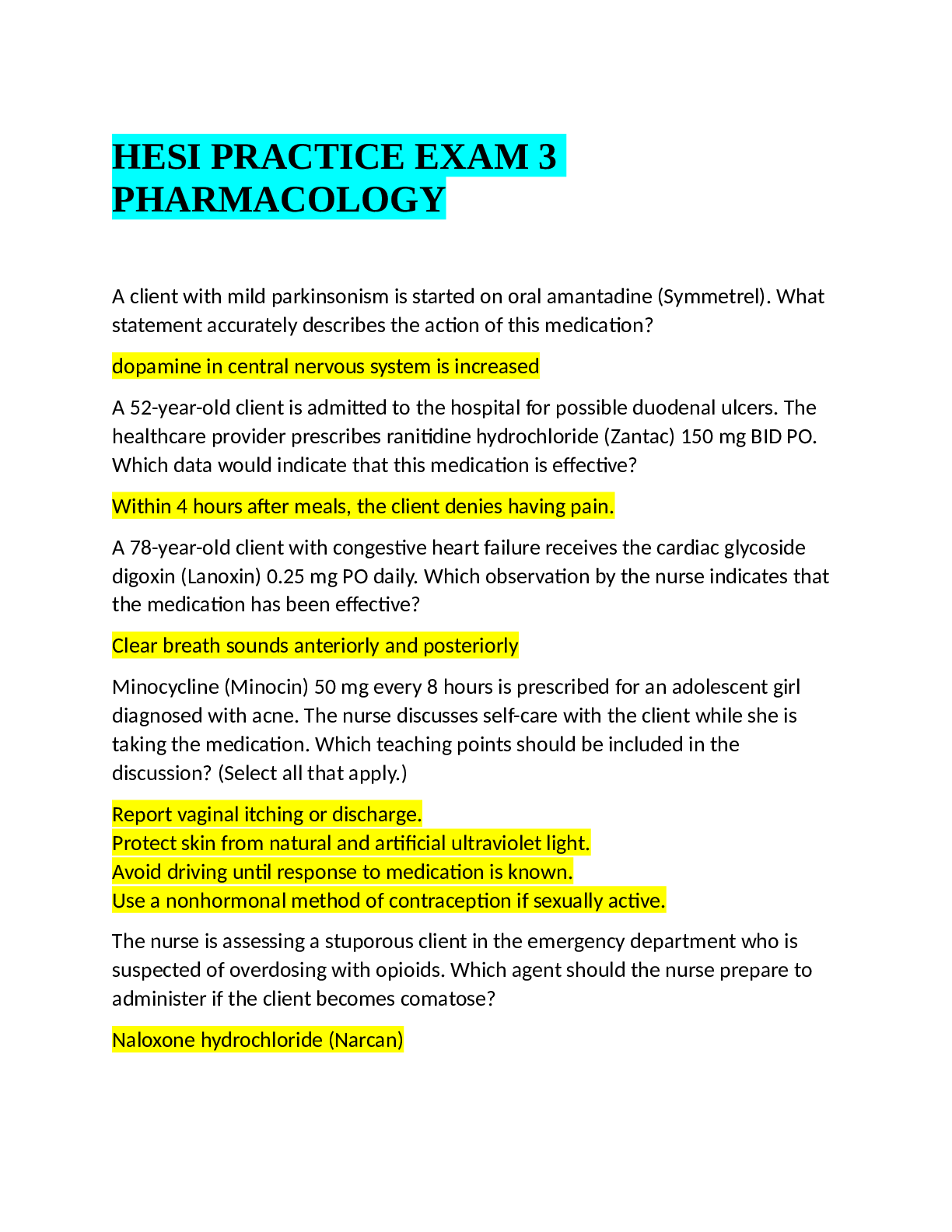




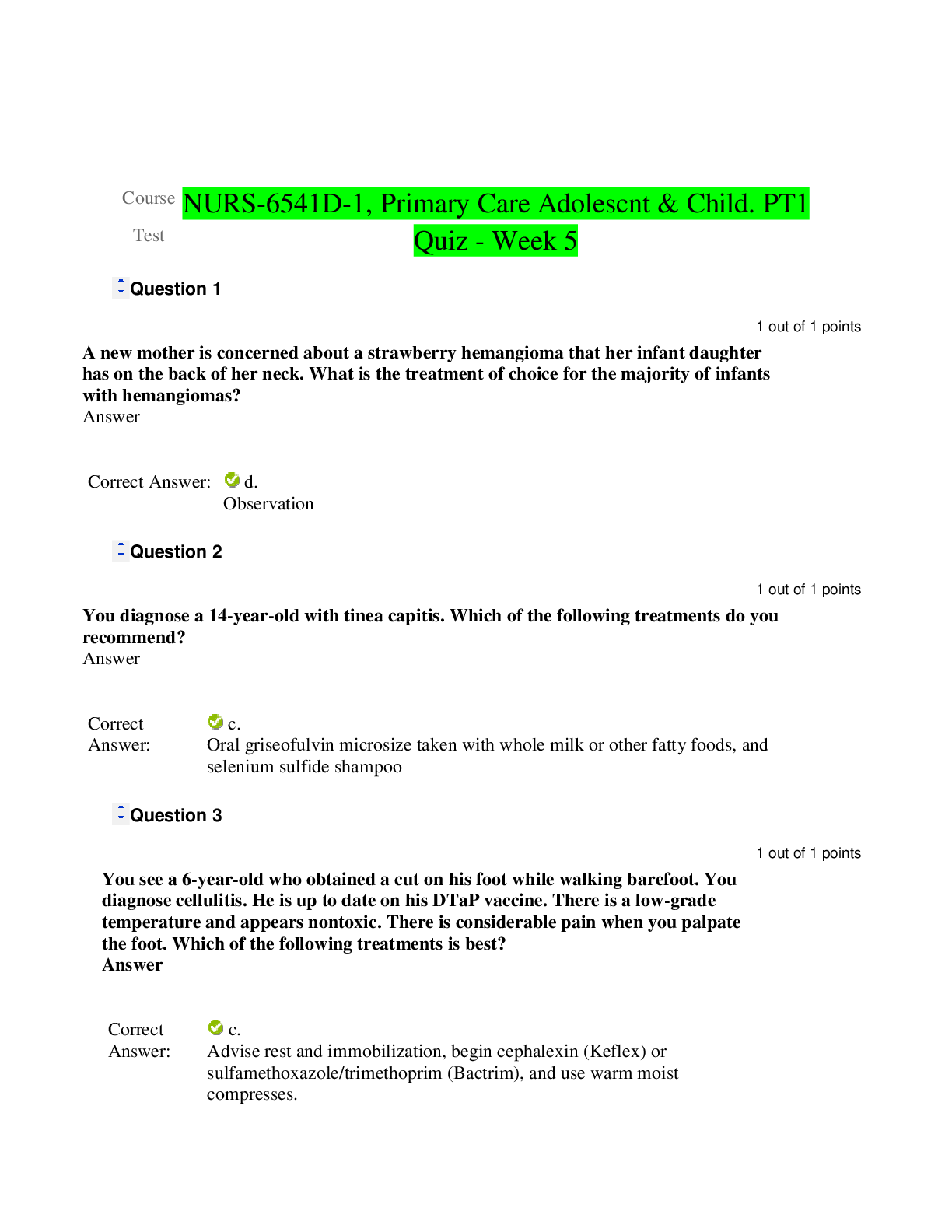
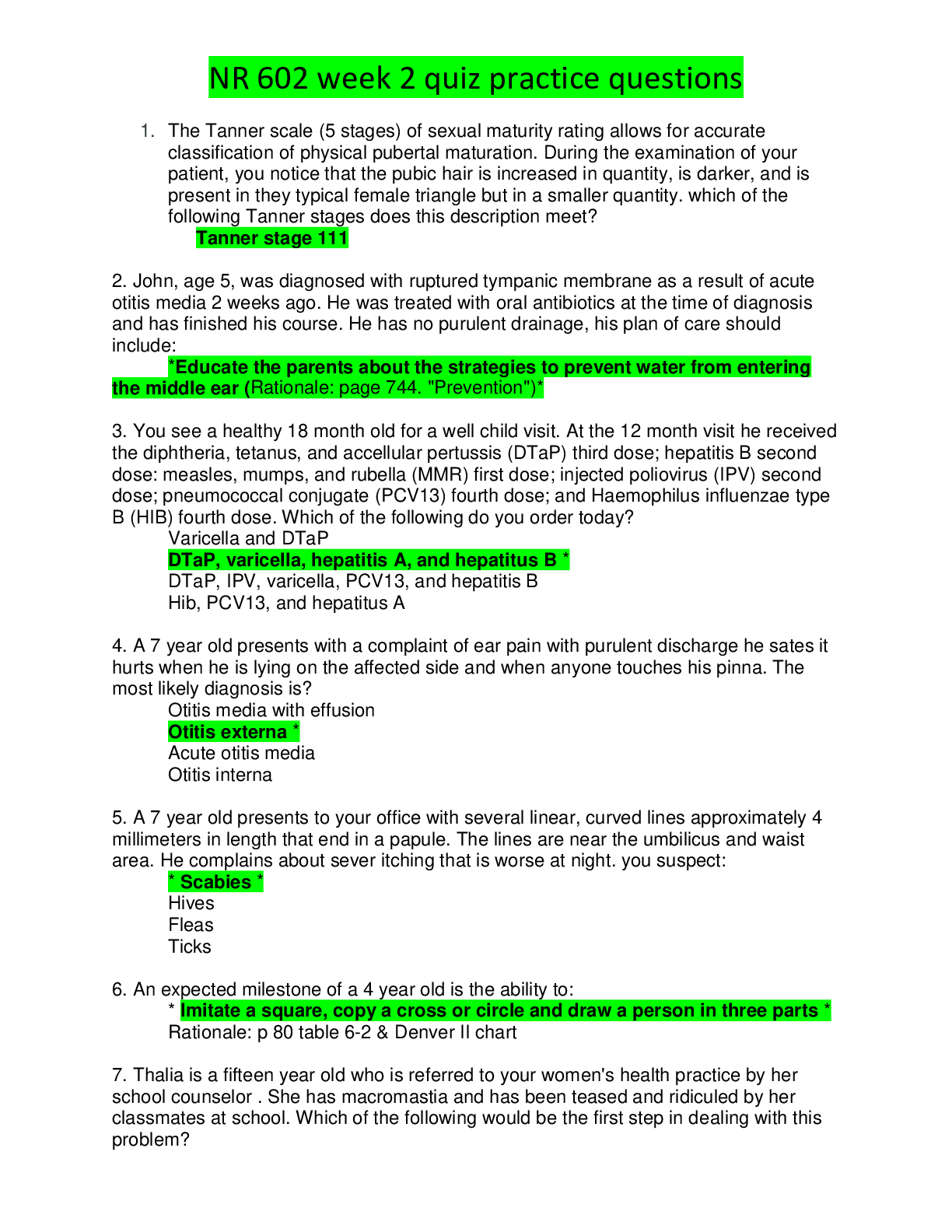
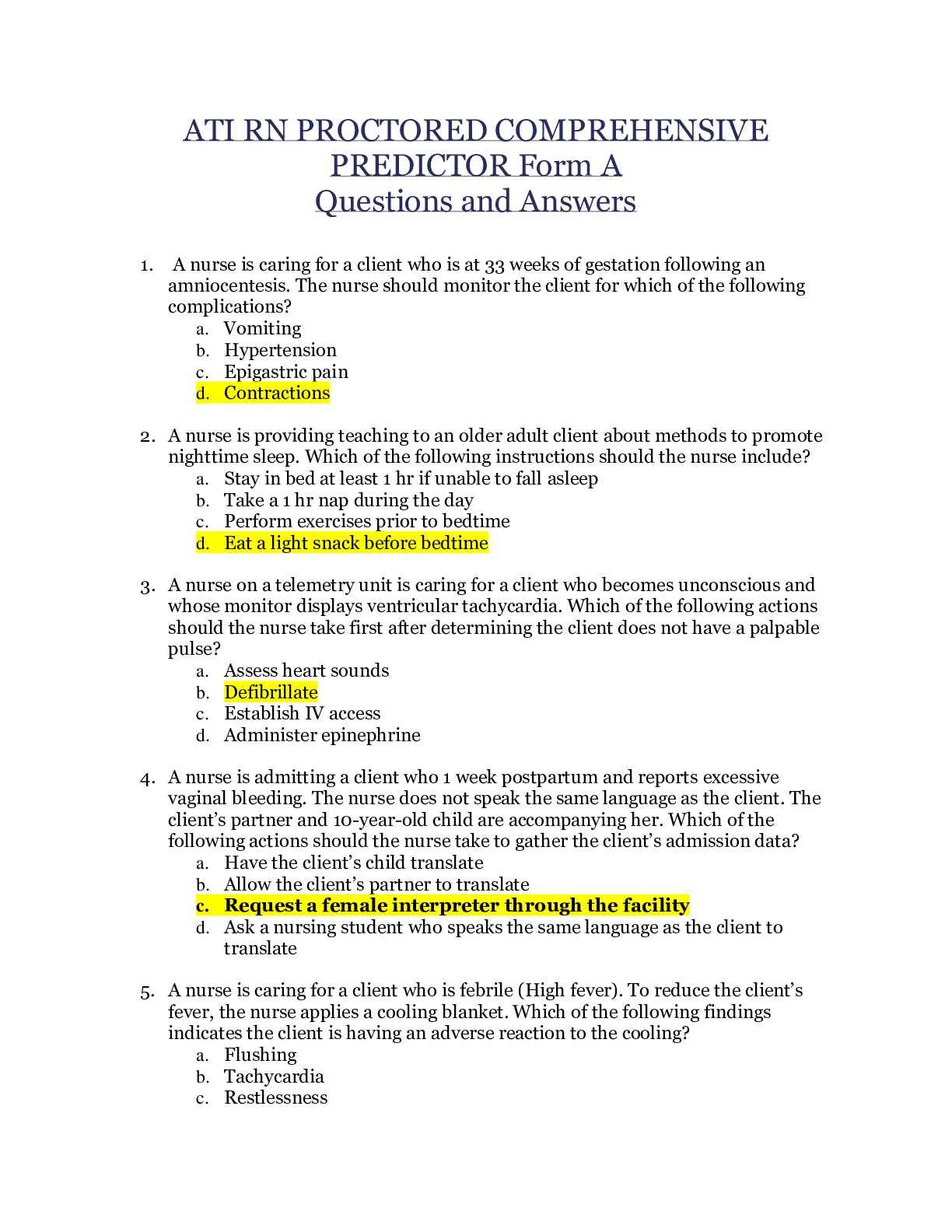
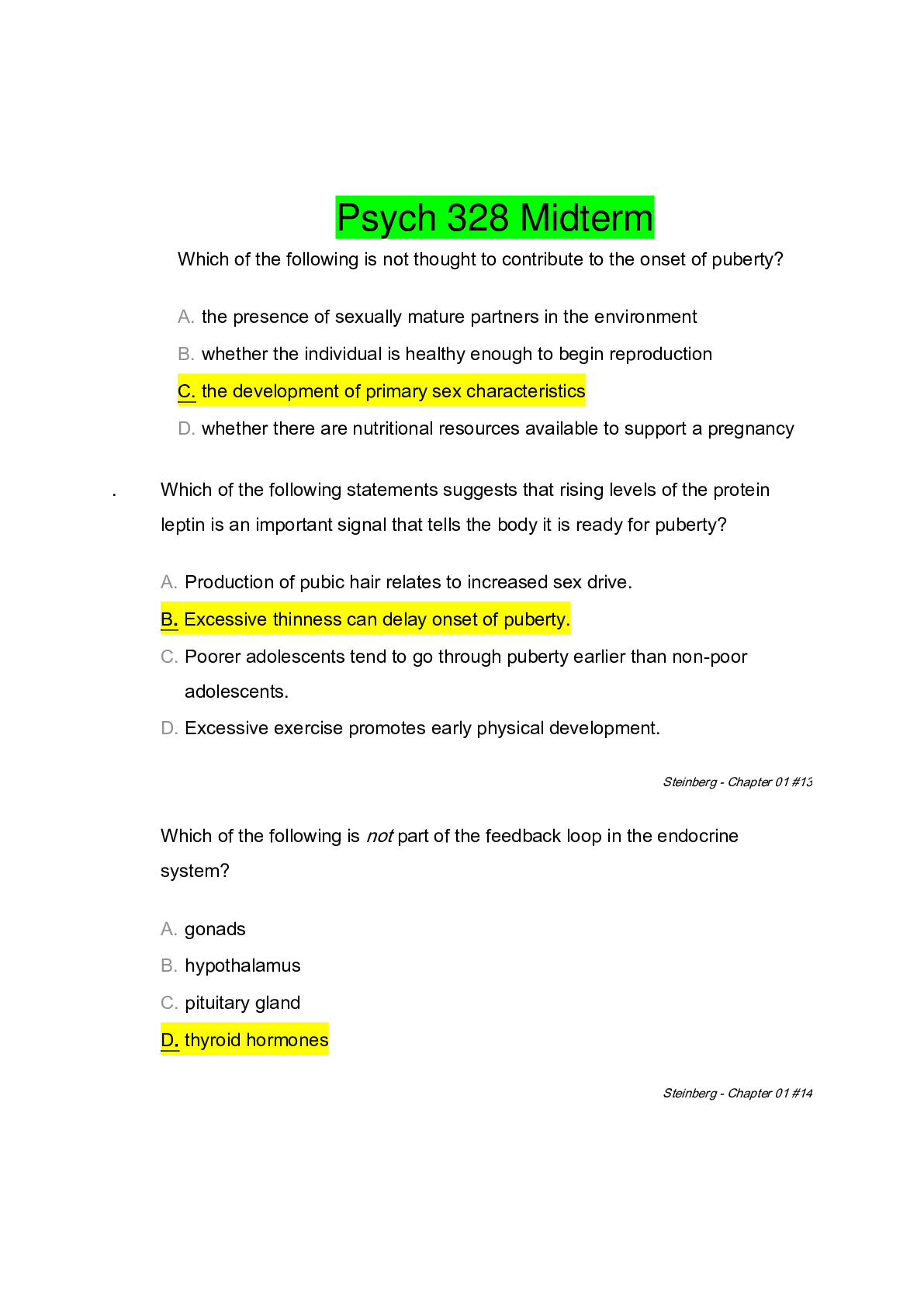






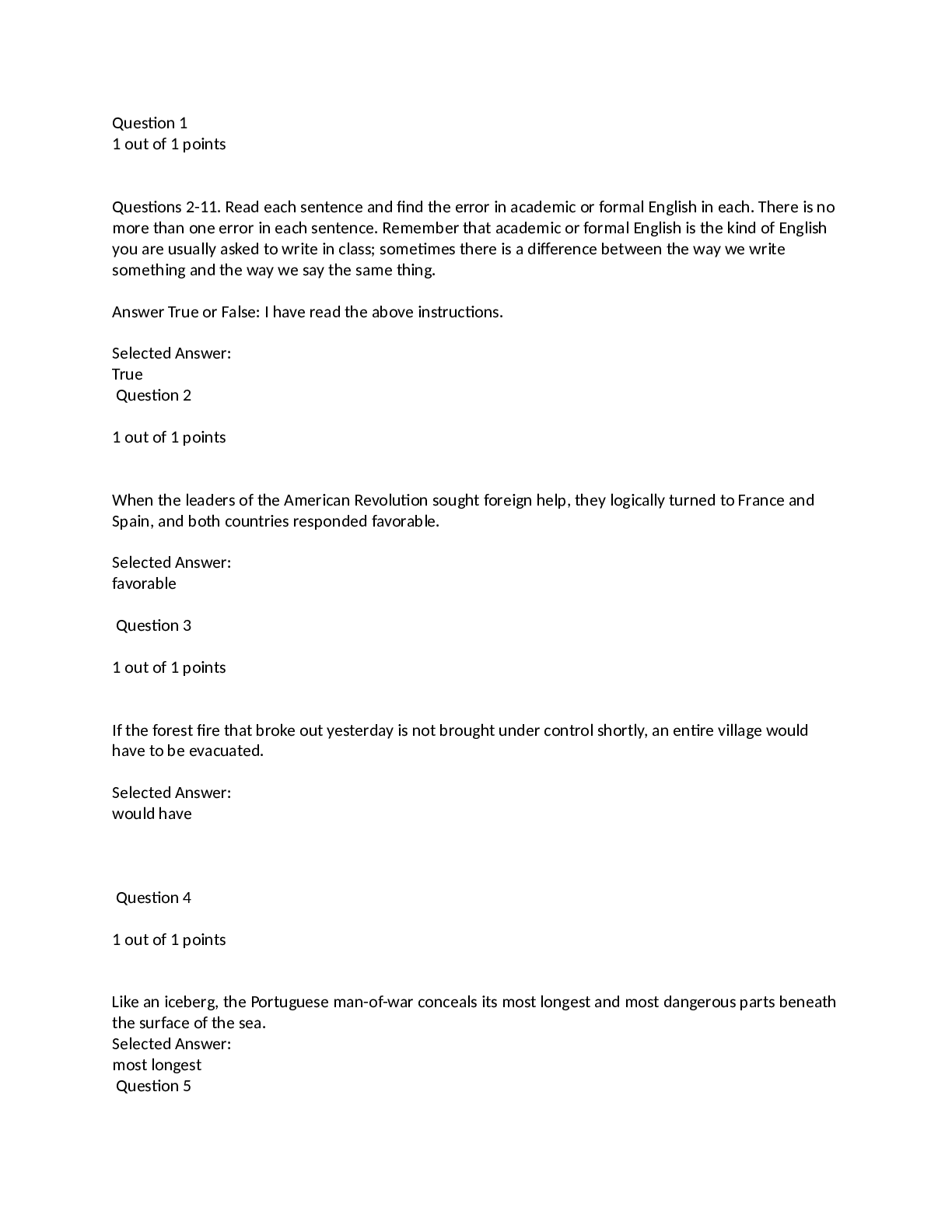
.png)
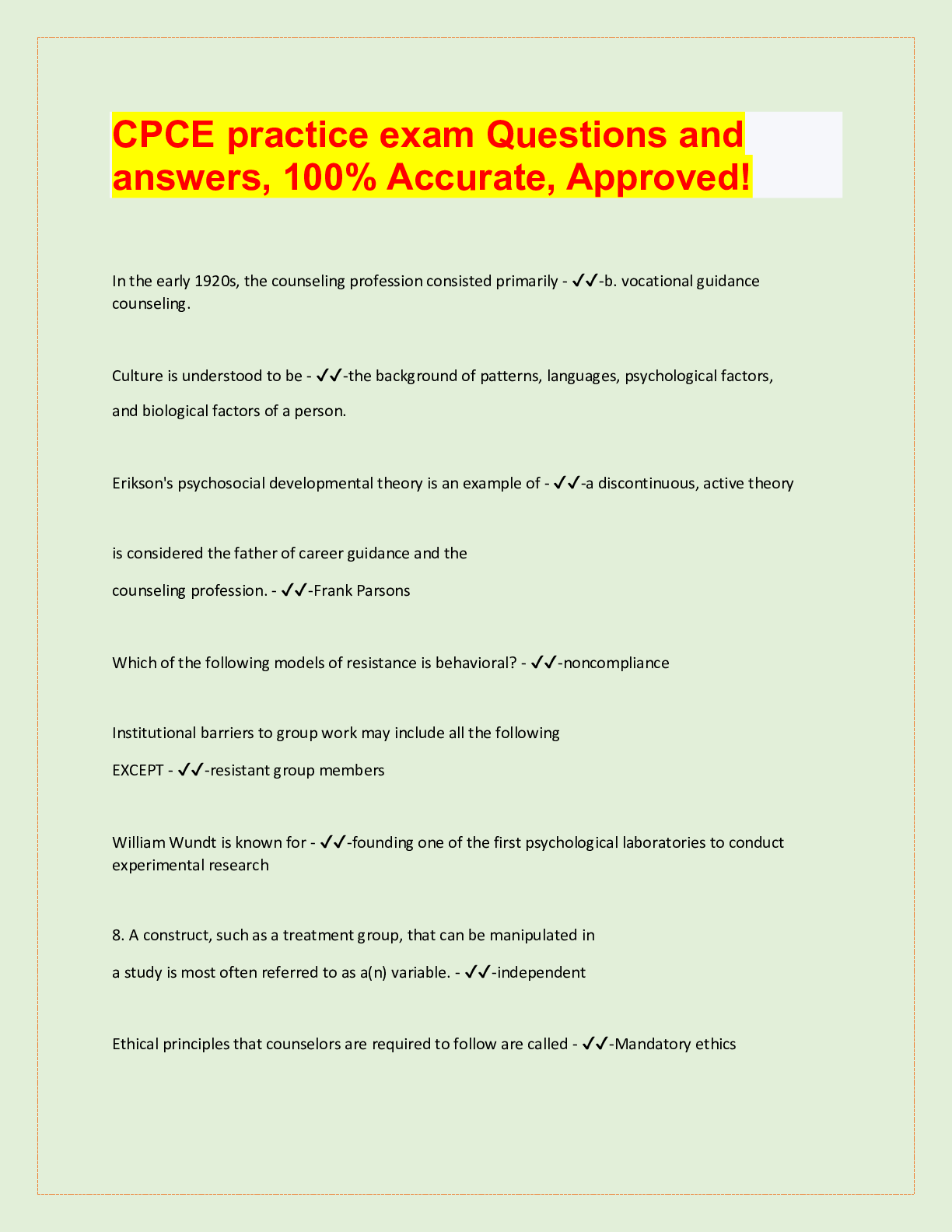
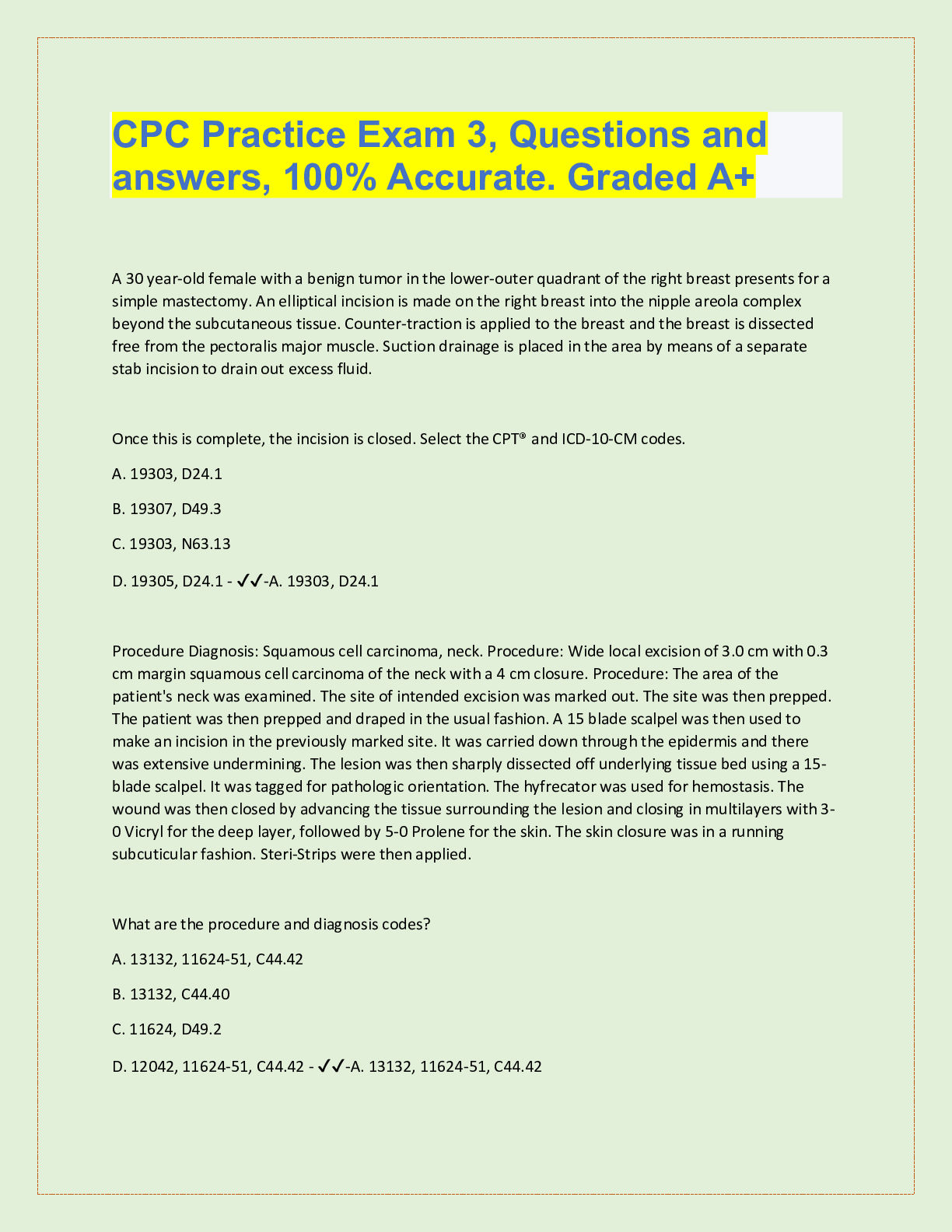
.png)


.png)


.png)

